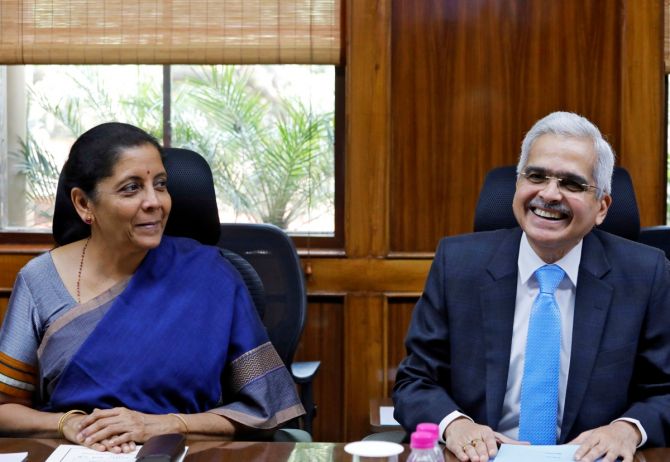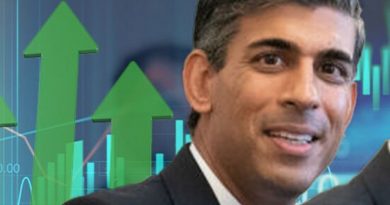‘Economic activities are expected to improve’
‘We are very watchful about inflation and growth. But the main challenge is economic revival and growth’
“Individuals and businesses have better adapted to Covid protocols. So, we feel that the worst of the second wave is behind us,” Reserve Bank of India Governor Shaktikanta Das tells Anup Roy and Vishal Chhabria.
You have said the impact of the second wave of COVID-19 could be limited to the first quarter, but your (RBI) survey in the Financial Stability Report says business expectations are down; the job scenario, wages, and productivity are unlikely to improve in the short term…
Activities had revived in the fourth quarter of last year, and in the second half the economy had emerged out of contraction and had entered positive territory.
Then we had the interruption of the second wave, which peaked in May.
If you look at the high speed indicators, sequentially there are growing signs of improvement in certain indicators. For example, data on freight traffic, GST e-way bills, import and export, electricity consumption, volume of transactions in the payment and settlement systems are showing sequential improvement.
The lockdowns were localised this time and economic activities, including manufacturing, continued.
Individuals and businesses have better adapted to Covid protocols. So, we feel that the worst of the second wave is behind us.
Economic activities are expected to improve further going into July or into the second half.
Further, congenial financial conditions continue to prevail and vaccination is gathering pace.
We made our detailed assessment on that basis, and we feel our projection of 9.5 per cent is quite realistic.
The numbers probably capture the formal economy. How do we gauge the informal economy, where the impact could have been much more?
In the rural areas there was good agricultural production last year, and there are expectations of a good monsoon this year.
Both of them provide strong support to the rural sector and going forward that should support rural demand and also incomes.
We do our own internal assessments and surveys to gauge informal economy data.
RBI’s resolution framework 2.0 was specifically targeted at the MSMEs and small businesses.
We have also provided targeted liquidity support through the banks, including the small finance banks and through them to the smaller NBFCs (non-banking financial companies) and the microfinance institutions.
The FSR says the true state of bank balance sheets will be revealed once the effects of regulatory forbearance fully plays out, but your worst case estimate this year is better than the best case estimate of last year, in terms of non-performing assets…
When we came out with the last FSR in January, the regulatory forbearances were still in operation.
The Supreme Court had ordered asset classification standstill immediately after the six months moratorium was over and our resolution framework 1.0 was still under implementation.
So, therefore, asset quality recognition was camouflaged because of these dispensations. So, the FSR had relied upon the figures of December 2019 as the base because it was not contaminated by the Covid numbers.
In the July 2021 FSR, we have a clearer picture of bad debts.
The base of March 31, 2021, numbers are, therefore, far more realistic.
The second wave’s impact is something that we’ll see over the coming months. But having said that, I would like to add that Indian banks are far more resilient today than they were earlier.
Today, the GNPAs (gross non-performing assets) are about 7.5 per cent.
The provision coverage ratio is close to 69 per cent, capital adequacy ratio is about 16 per cent.
So, therefore, in terms of resilience, the banks are in a better place today.
Having said that, there is also a necessity to continuously monitor and augment the capital adequacy of banks, given the overall uncertain outlook on the Covid front.
If there is an unexpected rise in bad debts, will RBI extend a helping hand to banks in terms of regulatory dispensation?
I would not like to comment on what we would do in future, but let me make one thing clear: RBI, as an institution, would not like to delay or postpone any asset quality recognition.
It is always better that the asset quality is recognised in time and addressed and resolved in time.
RBI has decided to look past inflation for now. But, inflation is sticky and the real interest rate is negative. Are you worried?
The headline inflation, and inflationary expectations were well anchored at 4 per cent before the onset of the pandemic.
We would like to consolidate and preserve those gains.
Stable inflation has its advantages in terms of reducing uncertainty for investors, for businesses, for everybody, and eventually it supports growth. But then we had an extraordinary situation arising because of the pandemic.
The flexible inflation targeting framework allows us to target within a range of 2-6 per cent.
The Monetary Policy Committee, therefore, focused on keeping headline inflation within this range.
The consumer inflation narrative comes from other emerging economies’ central banks, some of them have increased their rates, of course, but the narrative is that it is a transitory phenomenon.
The current inflation spike appears to be transitory, driven largely by supply side factors and going forward, it is expected to moderate in the third quarter.
We are very watchful of the emerging inflation trends and momentum. Any hasty withdrawal of monetary policy support will negate the nascent or incipient recovery that is taking place.
So, therefore, RBI will remain watchful. And the MPC will take appropriate decisions depending on the evolving situation.
You have shifted your guidance to state based, from time based. Why so?
As I said, any hasty withdrawal can undo the gains in the face of economic revival.
In 2020, the CPI inflation exceeded 6 per cent in July-August and 7 per cent in September-October. But the MPC believed that inflation would moderate in December and January.
So, the MPC decided to continue with the accommodative stance with the belief that inflation was transitory.
The MPC focussed on assuaging market expectations of an inflation spike.
Sure enough, inflation came down to little above 4 per cent during December 2020-March 2021.
In hindsight, the time-based guidance provided by the MPC was the right call to take because it anchored market expectations.
We are monitoring the inflation situation closely and we now feel that the state-based guidance is appropriate in the current context.
Are you not building up expectations in the market? The bond market seems to be assured that whatever happens to inflation, bond yields will remain stable.
We are very watchful about inflation and growth. But the main challenge is economic revival and growth.
Let us not forget that 2020-2021 witnessed a severe contraction of 7.3 per cent and the 9.5 per cent growth projection for the current year is built on that.
The economy needs to reach and exceed the pre-pandemic level of growth.
We are acutely conscious and sensitive to the fact that a hasty reversal of monetary policy stance or monetary policy approach can have serious consequences for the economic recovery. But we also want to anchor inflation expectations within the tolerance band and closer to the inflation target in the medium term.
The current inflection in inflation is also largely impacted by supply side issues.
International commodities and crude prices have also risen.
The government has taken certain supply side measures in recent weeks, but more supply side measures are necessary and we are actually looking forward to more such measures, especially on taxes from both central and state governments.
Feature Presentation: Rajesh Alva/Rediff.com
Source: Read Full Article



